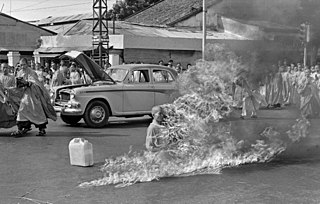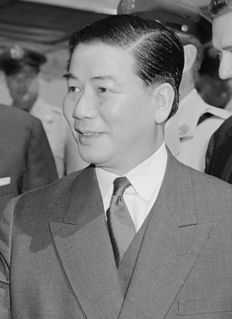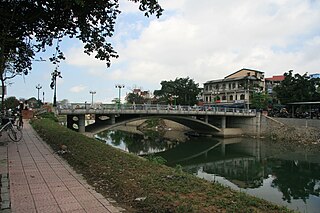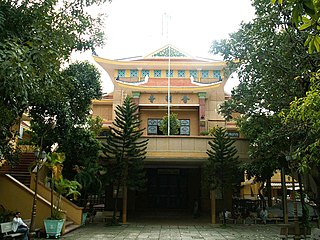 W
WThe Buddhist crisis was a period of political and religious tension in South Vietnam between May and November 1963, characterized by a series of repressive acts by the South Vietnamese government and a campaign of civil resistance, led mainly by Buddhist monks.
 W
WIn November 1963, President Ngô Đình Diệm of South Vietnam was deposed by a group of Army of the Republic of Vietnam officers who disagreed with his handling of both the Buddhist crisis and the Viet Cong threat to the regime. In South Vietnam, the coup was referred to as Cách mạng 1-11-63.
 W
WThe Army of the Republic of Vietnam Special Forces were the elite military units of the Army of the Republic of Vietnam (ARVN). Following the establishment of the Republic of Vietnam in October 1955, the Special Forces were formed at Nha Trang in February 1956. During the rule of Ngô Đình Diệm, the Special Forces were run by his brother, Ngô Đình Nhu, until both were assassinated in November 1963 in a coup. The Special Forces were disbanded in 1975 when South Vietnam ceased to exist after the Fall of Saigon.
 W
WDEPTEL 243, also known as Telegram 243, the August 24 cable or most commonly Cable 243, was a high-profile message sent on August 24, 1963, by the United States Department of State to Henry Cabot Lodge, Jr., the US ambassador to South Vietnam. The cable came in the wake of the midnight raids on August 21 by the regime of Ngo Dinh Diem against Buddhist pagodas across the country, in which hundreds were believed to have been killed. The raids were orchestrated by Diem's brother Ngô Đình Nhu and precipitated a change in US policy. The cable declared that Washington would no longer tolerate Nhu remaining in a position of power and ordered Lodge to pressure Diem to remove his brother. It said that if Diem refused, the Americans would explore the possibility for alternative leadership in South Vietnam. In effect, the cable authorized Lodge to give the green light to Army of the Republic of Vietnam (ARVN) officers to launch a coup against Diem if he did not willingly remove Nhu from power. The cable marked a turning point in US-Diem relations and was described in the Pentagon Papers as "controversial." The historian John M. Newman described it as "the single most controversial cable of the Vietnam War."
 W
WThe Double Seven Day Scuffle was a physical altercation on July 7, 1963, in Saigon, South Vietnam. The secret police of Ngô Đình Nhu—the brother of President Ngô Đình Diệm—attacked a group of US journalists who were covering protests held by Buddhists on the ninth anniversary of Diệm's rise to power. Peter Arnett of the Associated Press (AP) was punched on the nose, and the quarrel quickly ended after David Halberstam of The New York Times, being much taller than Nhu's men, counterattacked and caused the secret police to retreat. Arnett and his colleague, the Pulitzer Prize-winning journalist and photographer Malcolm Browne, were later accosted by policemen at their office and taken away for questioning on suspicion of attacking policemen.
 W
WThích Quảng Đức was a Vietnamese Mahayana Buddhist monk who burned himself to death at a busy Saigon road intersection on 11 June 1963. Quảng Đức was protesting the persecution of Buddhists by the South Vietnamese Roman Catholic government led by Ngô Đình Diệm. Photographs of his self-immolation were circulated widely around the world and brought attention to the policies of the Diệm government. John F. Kennedy said in reference to a photograph of Quảng Đức on fire, "No news picture in history has generated so much emotion around the world as that one." Malcolm Browne won a Pulitzer Prize for his photograph of the monk's death.
 W
WThe Huế chemical attacks occurred on 3 June 1963, when soldiers of the Army of the Republic of Vietnam (ARVN) poured liquid chemicals from tear gas grenades onto the heads of praying Buddhists in Huế, South Vietnam. The Buddhists were protesting against religious discrimination by the regime of the Roman Catholic President Ngô Đình Diệm. The attacks caused 67 people to be hospitalised for blistering of the skin and respiratory ailments.
 W
WThe Huế Phật Đản shootings were the deaths of nine unarmed Buddhist civilians on 8 May 1963 in the city of Huế, South Vietnam at the hands of the army and security forces of the government of Ngô Đình Diệm, a Roman Catholic. The army and police fired guns and launched grenades into a crowd of Buddhists who had been protesting against a government ban on flying the Buddhist flag on the day of Phật Đản, which commemorates the birth of Gautama Buddha. Diệm denied governmental responsibility for the incident and blamed the Việt Cộng, which added to discontent among the Buddhist majority.
 W
WThe Krulak–Mendenhall mission was a fact-finding expedition dispatched by the Kennedy administration to South Vietnam in early September 1963. The stated purpose of the expedition was to investigate the progress of the war by the South Vietnamese regime and its US military advisers against the Viet Cong insurgency. The mission was led by Victor Krulak and Joseph Mendenhall. Krulak was a major general in the United States Marine Corps, while Mendenhall was a senior Foreign Service Officer experienced in dealing with Vietnamese affairs.
 W
WThe McNamara–Taylor mission was a 10-day fact-finding expedition to South Vietnam in September 1963 by the Kennedy administration to review progress in the battle by the Army of the Republic of Vietnam and its American advisers against the communist insurgency of the National Liberation Front of South Vietnam. The mission was led by US Secretary of Defense Robert McNamara and General Maxwell D. Taylor, the Chairman of the Joint Chiefs of Staff.
 W
WThe arrest and assassination of Ngô Đình Diệm, the president of South Vietnam, marked the culmination of a successful coup d'état led by General Dương Văn Minh on 1 November 1963. The coup was the culmination of nine years of autocratic and nepotistic family rule in South Vietnam. Discontent with the Diệm regime had been simmering below the surface and exploded with mass Buddhist protests against long-standing religious discrimination after the government shooting of protesters who defied a ban on the flying of the Buddhist flag.
 W
WNgô Đình Diệm was a Vietnamese politician. He was the final prime minister of the State of Vietnam (1954–55), and then served as President of South Vietnam from 1955 until he was deposed and assassinated during the 1963 military coup.
 W
WTrần Lệ Xuân, more popularly known in English as Madame Nhu, was the de facto First Lady of South Vietnam from 1955 to 1963. She was the wife of Ngô Đình Nhu, who was the brother and chief advisor to President Ngô Đình Diệm. As Diệm was a lifelong bachelor and because she and her family lived in Independence Palace together with him, she was considered to be the first lady.
 W
WThe reaction to the 1963 South Vietnamese coup that saw the arrest and assassination of Ngô Đình Diệm was mixed.
 W
WThe Xá Lợi Pagoda raids were a series of synchronized attacks on various Buddhist pagodas in the major cities of South Vietnam shortly after midnight on 21 August 1963. The raids were executed by the Army of the Republic of Vietnam Special Forces under Colonel Lê Quang Tung, and combat police, both of which took their orders directly from Ngô Đình Nhu, younger brother of the Roman Catholic President Ngô Đình Diệm. Xá Lợi Pagoda, the largest pagoda in the South Vietnamese capital, Saigon, was the most prominent of the raided temples. Over 1,400 Buddhists were arrested, and estimates of the death toll and missing ranged up to the hundreds. In response to the Huế Vesak shootings and a ban on the Buddhist flag in early May, South Vietnam's Buddhist majority rose in widespread civil disobedience and protest against the religious bias and discrimination of the Catholic-dominated Diệm government. Buddhist temples in major cities, most prominently the Xá Lợi pagoda, became focal points for protesters and assembly points for Buddhist monks from rural areas.